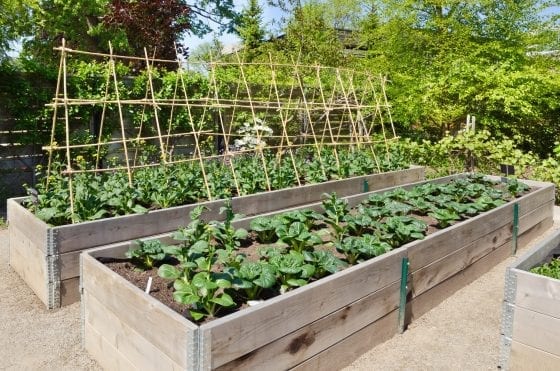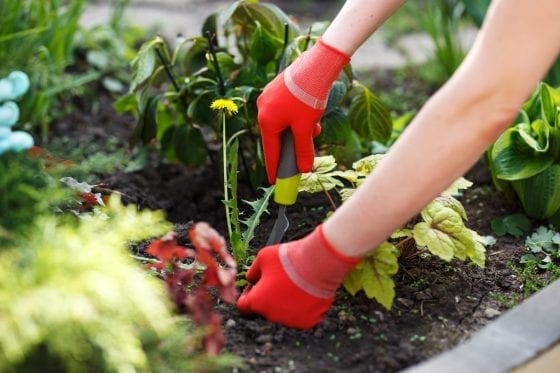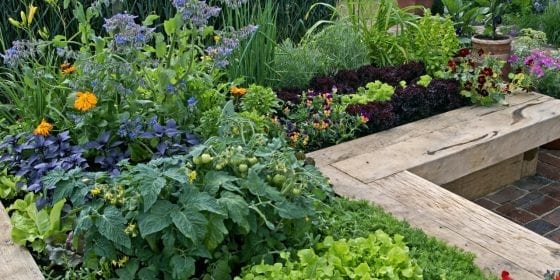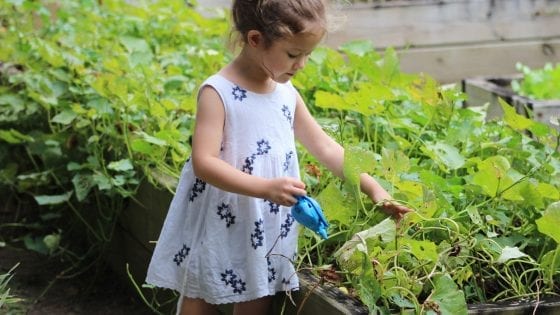A raised planter box or raised garden bed – takes it to the next level with a box that is counter-height which makes it easier to take care of your little garden. Here are some tips for a successful raised garden bed that will help you take the most advantage of your garden year after year.
If you are looking into taking your garden to the next level this Spring season then you are in the right place.
Use a raised planter box to get all the advantages of a traditional garden with a lot less work. You’ll spend less time pulling weeds and more time using rich soil to grow your raised bed garden.
Whether you fill them with vegetables, flowers, or herbs, you’ll enjoy the convenience of having a designated area to grow them.
Traditional in-ground gardens are great, but there’s something to be said for raised bed gardens. It allows you to grow more food in less space, tailor the soil precisely to your needs, and decreases the amount of space for weeds to grow wild.
Plus, the soil in a raised bed warms earlier in the spring than in-ground garden beds, so you can get planting sooner.
Raised planter beds are a step up from a container garden, giving you more room for everything you want to grow. Learn how to DIY a raised garden bed here.
HOW TO BUILD A RAISED BED
- Pick the perfect spot.
- Choose the material for your raised bed.
- Determine bed size and layout.
- Build your raised beds.
- Line the bottom of your beds.
- Fill your raised beds with soil.
- Plant your veggies.
Tips for a Successful Raised Garden Bed
1. Fluff the Soil as Needed
To lighten compacted soil in your raised bed between seasons, simply stick a garden fork as deeply into the soil as possible and wiggle it back and forth.
Do that in 8- to 12-inch intervals all over the bed, and your soil will be nicely loosened without a lot of backbreaking work.
2. Cover up Your Soil, Even When You’re Not Gardening
Add a layer of organic mulch or plant a cover crop at the end of your growing season. Soil that is exposed to harsh winter weather can break down and compact much faster than protected soil.
Plus, by adding a cover crop, you can increase the soil fertility as the crop breaks down after it’s turned into the soil.
3. Create a Pretty, Edible Garden.
Even the simplest raised bed can turn into a pretty destination in your garden. Plan an aesthetically pleasing arrangement of your favorite edibles.
Pair them with beautiful blooming companion plants to attract beneficial insects to the garden, and you can create a living work of art–and boost your harvests.
By adding flowers along the border of your raised bed, pollinators will be attracted to the blooms.
Helping to pollinate your crops, too, for increased yields. Additionally, beneficial predatory insects will also enjoy the flowers, but will help compact pests in the garden, too.
4. Think Ahead to Extend the Season
A little planning up front can enable you to grow earlier in the season or extend your growing season well into the fall.
Consider installing supports for a simple low tunnel or cold frame, and you’ll have minimal work when you need to protect your crops from frost.
I live in a fairly, year-round, warm state. In my case I have old blankets that I have set aside for my garden for the colder season.
5. Mulch After Planting
Mulch with straw, grass clippings, leaves, or wood chips after planting your garden. This will reduce the amount of weeding you’ll have to do and keep the soil moist.
6. Don’t Walk on the Soil
The biggest advantage of raised bed gardening is the light, fluffy, absolutely perfect soil you can create.
When you build your raised beds, build them so that you’re able to reach every part of the bed without having to stand in it.
If you already have a raised bed and find that you have to walk on parts of it, consider installing strategically placed patio pavers or boards, and only step on those rather than on the soil.
To learn how to DIY a raised garden bed check this post out!
Do you have a garden at home? Maybe a raised garden bed or a container garden. Share with us in the comment section below.

Hi there! I’m Wanda – the creator and author at My Sweet Zepol a healthy food, travel, and lifestyle blog. Passionate about food photography, food styling, entertaining and advocate about creating memories around the kitchen table. With a mission to create easy-to-make meals for the busy family.





This is so perfectly done! If we only have enough space I would definitely make a couple of bed.
Thank you! Wall mounts for garden beds or even single pots can be a great way to incorporate a garden with limited space.
These are great tips. I am excited to start my garden soon once it warms up
I’m excited too! Would love to hear how it turns out.
I would love to make one of these. I think it would be great for my family. We love having a garden, and the raised beds would really be nice.
It would be. I love incorporating my daughters when it comes to getting fresh air and gardening with me!
I can’t wait for us to buy a home so that we can have a raised garden!
I can’t wait to hear about it when you do!
I was really wanting to do a raised bed this year, but I don’t think it’s happening. Definitely next year though!
Keep working towards it and it will happen!